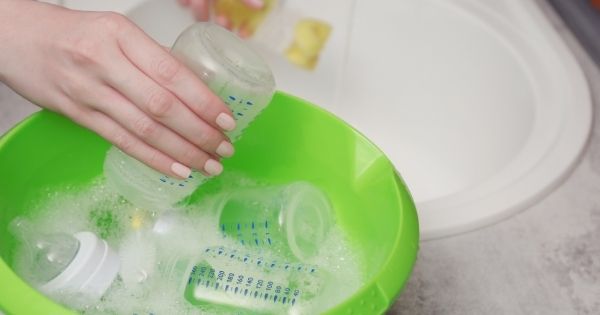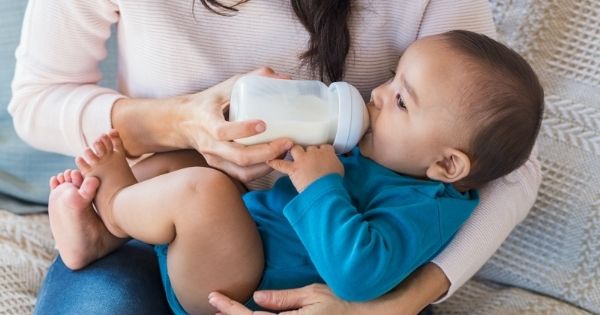A baby’s immune system is not yet fully developed, which means he does not have sufficient antibodies to combat infections. This makes him especially vulnerable to illnesses such as dangerous gastroenteritis which causes diarrhoea, vomiting, and dehydration. Sterilizing baby bottles, weaning and feeding equipment is the best way to keep baby safe.
***Disclosure -The links in this post may contain affiliate links and I may receive a small commission if you make a purchase after clicking on a link.***

What Baby Items Must Be Sterilized?
Bottles and teats
Bottles and teats must be sterilized throughout your baby’s first year until his immune system is more equipped for fighting off germs. You might wonder if it is necessary since you baby places almost everything he can find into his mouth. However, even the smallest milk residue could be the ideal breeding ground for nasty bacterial critters. Wash baby items with a small bottle brush shortly after a feed and pay special attention to the teats. Be sure to turn them inside out and make sure they are clean. Rinse everything before sterilizing.
Pacifiers
Babies drop their pacifiers on the ground all the time, therefore it is vital to sterilize them for six months at least. After six months you can wash them in hot soapy water and rinse afterwards. Be sure to squeeze out any water that is trapped inside.
Sippy cups
As per official guidelines, sippy cups should also be sterilized for six months after which only hand washing, or dishwasher cleaning is necessary. However, if your child is given milk in a sippy cup, it is a good idea to sterilize the lids.
Nipple shields and breast pumps
If you are nursing and expressing milk, all the equipment you are using must be sterilized as well until your baby reaches one year of age.
Feeding bowls and other weaning items
If you start introducing your little one to solids before six months, it is necessary to sterilize spoons, bowl, and other items. From six months, hot soapy washes will suffice.
Food containers
The containers that you use for storing your breastmilk must also be sterilized. Containers that are used for storing food only need a thorough wash once your baby reaches six months of age.
What are baby feeding items?
Baby feeding items include bottles, teats, rings, caps, and nipple shields. Some babies are fed with a medicine cup, syringe or spoon. Some baby bottles might have membranes or valves. All of these are considered baby feeding items and must be sterilized.
What does sterilizing baby bottles entail?
It is essential to sterilize all baby feeding items, including baby bottles, nipple shields, and teats for at least a year. This protects your baby against harmful bacteria and germs that cause diarrhoea, vomiting and dehydration.

Cleaning And Sterilizing Of Baby Equipment
Cleaning baby bottles by hand
- Baby bottles, teats, lids, and any other items that you are using for preparing baby’s feed must be thoroughly cleaned after use. Soon after baby finishes his feed, wash the bottle and all accessories.
- First wash your hands with warm water and soap to make sure they are clean.
- Use a clean container or basin for cleaning baby equipment. Refrain from washing them directly in the sink since there might be lingering germs that could potentially contaminate the items.
- Use hot water with soap to wash everything.
- Clean out all dried milk that may be stuck in the teat or baby bottle with a bottle brush. Squeeze water through the teat holes to make sure it is clean.
- Once everything is clean, rinse everything with water and allow it to air dry. This type of cleaning is essential for getting rid of any milk traces or formula that might be lingering inside the bottles.
- When finished, rinse the brush and wash basin thoroughly and leave them to air dry after use. Wash them thoroughly every now and again with hot water and use the heating cycle on the dishwasher, if possible. If your baby is younger than three months or was born pre-term or has an impaired immune system due to illness (cancer, HIV, etc) be sure to wash the basin and bottle brush after each use.
Cleaning feeding equipment in the dishwasher
- First ensure the items are dishwasher safe.
- Take everything apart. Separate all baby bottle parts like the caps, nipples, valves, etc.
- Rinse everything under running water (hot or cold).
- Place all parts in the dishwasher with small parts in the closed top compartment or inside a laundry bag.
- When possible choose the hot water washing and heated drying cycles. This could help with killing more germs. If you have a sanitizing setting, even better.
- Remove everything from the dishwasher. Remember to thoroughly wash your hands with water and soap prior to removing items and storing them. If they are not dry, put them on a clean unused paper towel or dish towel and allow to air dry before putting them away in a dust and dirt-free zone. Never use a dish towel to dry items because you can transfer germs.
Why is sanitizing necessary after washing baby equipment?
Just bear in mind, that washing alone is not a fool proof way for ensuring all feeding items are entirely germ-free. That is why sterilization is necessary afterwards.
Note: If the dishwasher has hot water and heated drying (or sanitizing) options for cleaning baby’s feeding items, separate sanitizing is not needed. For added protection, sanitize all feeding equipment at least once a day. Sanitizing is incredibly essential during the first three months of a baby’s life. Before sanitizing, ensure all items were cleaned. Everything must be sanitized, even the bottle brush and basin. Here are the different methods of sanitizing you can consider.
Why Is Sterilizing Baby Bottles Necessary?
Sterilizing baby bottles is a process that entails killing any germs that might be clinging onto bottles and other baby items that might be potentially harmful to your baby.
There are several different methods of sterilizing baby bottles, lids, teats, and other feeding objects. Make sure all lids, bottles, teats and feeding utensils are thoroughly cleaned prior to sterilizing.
4 Methods Of Sterilizing Baby Feeding Items
Boiling
Boiling is effective through elevating the temperature to kill any bacteria that might be lingering after cleaning.
- Place baby bottles, lids, teats, and other items in a saucepan on the back plate of the stove, but do not turn it on yet.
- Add enough water to ensure everything is submerged with not air bubbles present.
- Bring the water to boiling point and boil rapidly for about five minutes.
- Turn of the stove and leave the saucepan on the plate until the water is cooled down.
- Wash hands properly before touching the equipment and the surface where you are planning on making up a bottle must be disinfected.
- Remove the items from the saucepan and shake of the excess water.
- If you are not using any items right away, place the teat and lid on the bottle and store them in a clean container in your fridge.
- Before using the bottle and other items, re-boil if you have not used it within twenty-four hours.
Using chemicals to sterilize baby items
Chemical baby sterilizers are disinfectant emulsions are available in tablet or liquid forms that are diluted in water.
- Prepare the sterilizing solutions a per manufacturer guidelines.
- Make sure you read the instructions carefully prior to preparing it.
- Place all feeding items in the sterilizing emulsion, making sure they are submerged and check that no air bubbles are present.
- Leave everything to sterilize for about half an hour or as per recommended instructions.
- Allow everything to drain before using them and do not rinse the solution to prevent exposure to germs.
- Discard the solution after a day and sterilize the container that was used for sterilizing with hot soapy water before adding fresh solution next time.
Using microwave or electric sterilizers to steam baby items
Similar to boiling, steaming is where the temperature is hot enough in order to kill any bacteria. There are various types of sterilizers to choose from. Always follow the manufacturer’s instructions when using.
- Place the bottles, lids, and teats in the sterilizer with the openings facing downwards.
- Check the instructions for adding the water and turn the unit on.
- Leave everything in the sterilizer until needed.
- If you do not need to use the baby bottles or other items immediately, check the instructions to see how long you can leave them in the sterilizer before they must be sterilized again.
Bleaching (if boiling, steaming, or using a dishwasher cannot be used)
- Add two teaspoons of unscented bleach to a gallon (sixteen cups) of water into a clean wash basin.
- Add the baby items to the solution, making sure they are submerged with no air bubbles.
- Squeeze the emulsion through the bottle nipples to make sure they are clean.
- Soak everything in the solution for another two minutes.
- Use your hands (after washing with warm water and soap for twenty seconds) or tongs to remove the items. Do not rinse and leave everything in a clean area to air dry. This sterilizing option is the same method they use for sterilizing dirty dishes in restaurants.
- After you have sterilized everything, leave them on an unused, clean power or dish towel in an area free from dust or dirt. Everything must be left to air dry before putting them away. Do not use a dish towel to dry them to avoid germ contamination.
Safety Tips For Sterilizing Baby Items
- Never leave boiling or hot liquids unsupervised or in reach of small children. Keep in mind that steam is dangerous as well since it can scald or burn just like boiling water.
- Keep any chemical or solutions in a place where children cannot reach it.
- Always wash your hands thoroughly with soapy water before handling baby items that were sterilized.
- Always keep the sterilized baby equipment covered. Re-assemble baby bottles that are sterilized and place their caps on.
- If any baby items were left uncovered, they must be sterilized again before use.
- When a sterilized bottle was left for a few days with the cap on, they tend to go musty, therefore they must be washed and sterilized again prior to using.
- Avoid patting sterilized baby items dry with a tea towel. They must be left to air dry after washing and sterilizing.
Cleaning A Breast Pump When You Are Breastfeeding
This article offers general guidelines for cleaning a breast pump. However, we highly recommend checking the manufacturer’s recommended guidelines for cleaning the pump.
Washing breast pump components
- Every breast pump part that comes into contact with you breast milk, like the valves, baby bottles and nipples shields must be cleaned after use. To keep the breast pump safe and sanitary you can wash away bacteria and germs with ordinary dishwash soap and warm water. Some parts are dishwasher safe and can be placed on the top rack. First check if the components can be washed in a dishwasher.
- Breast pump tubes does not have to be cleaned unless it came into contact with your milk. When tubing is washed, insure it air dries before attaching it to the pump. If tiny water drops (condensation) form inside the tube after pumping, turn the unit on for a few minutes until the tube is completely dry.
- You can buy microwave safe sterilizers for breast pump components, but these sterilizers do not always adhere to FDA sterilization standards. But they are used for sanitizing the parts, which is adequate for processing in between uses for one user.
Washing electrical units of powered breast pumps
- Electrical breast pumps that are powered with batteries and a motor must be wiped down, using a clean paper towel or a soft cloth after using.
- You must never clean the electrical unit with water or liquids. Also avoid cleaning it in a microwave sterilizer.
- There are breast pump wipes available for cleaning purposes which is highly convenient when you are traveling. Even if wipes are used, remember that breast pump components that have come in contact with your breast milk must be cleaned with warm water and soap before expressing.
Conclusion
We hope you have found this post helpful and that we have answered all your questions relating to cleaning and sterilizing baby bottles and other feeding items. Be sure to use our guide as reference to keep your baby safe against harmful bacteria and germs.
 Kaboutjie SA Mommy Blogs by Lynne Huysamen
Kaboutjie SA Mommy Blogs by Lynne Huysamen







Steralising is so important, especially as we faced with the current C19 virus. Babies are fragile and it’s useful to have a read at in depth articles like these which come in handy, especially on days when I forget to steralise babys soothers. Thanks for sharing. This has been useful.
Thank you so much for sharing this, my friend is a first time mom and battling with the chemical sterilization as baby has dry mouth, i bought her a microwave steri set and she didn’t trust it at all.
I showed her your blog Sunday night and she took alot of notes so hopefully she will find some comfort and peace of mind
It can be so daunting as a new mom to figure everything out and also figure out what works for your baby and what doesn’t!
Very informative post just as I return to work and begin bottle feeding. Thank you